
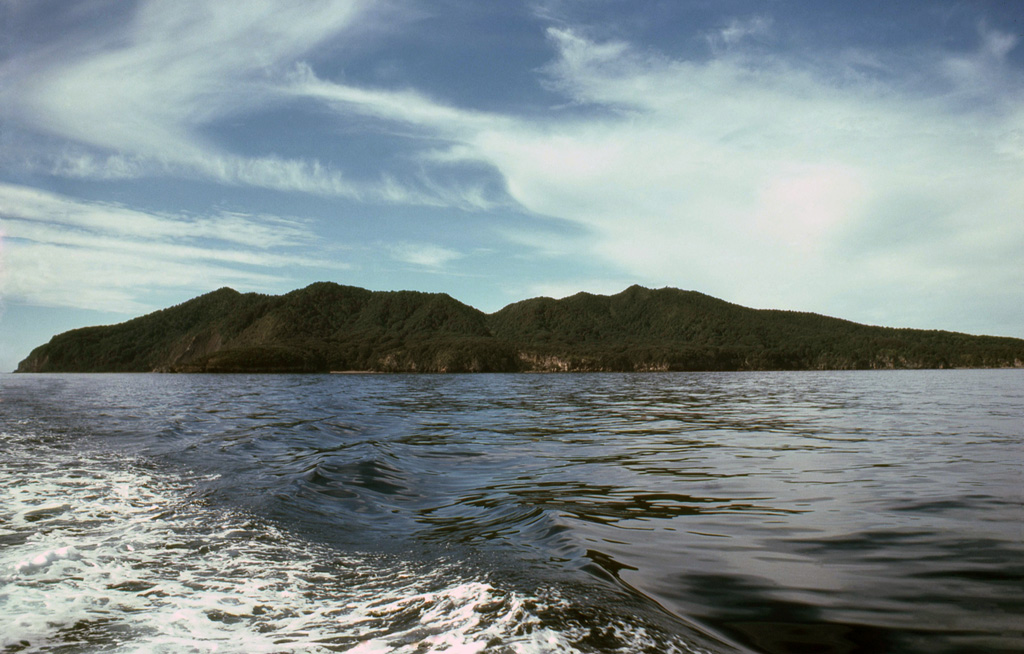
The Global Volcanism Program has no activity reports available for Tuhua/Mayor Island.
The Global Volcanism Program has no Weekly Reports available for Tuhua/Mayor Island.
The Global Volcanism Program has no Bulletin Reports available for Tuhua/Mayor Island.
|
|
||||||||||||||||||||||||||
There is data available for 2 confirmed Holocene eruptive periods.
5055 BCE ± 155 years Confirmed Eruption (Explosive / Effusive) VEI: 5
| Episode 1 | Eruption (Explosive / Effusive) | South end of caldera, Taratimi Bay | ||||||||||||||||||||||||||||||||||||||||||||||||||||||
|---|---|---|---|---|---|---|---|---|---|---|---|---|---|---|---|---|---|---|---|---|---|---|---|---|---|---|---|---|---|---|---|---|---|---|---|---|---|---|---|---|---|---|---|---|---|---|---|---|---|---|---|---|---|---|---|
| 5055 BCE ± 155 years - Unknown | Evidence from Isotopic: 14C (calibrated) | ||||||||||||||||||||||||||||||||||||||||||||||||||||||
| The 6,340 ± 190 BP Tuhua Tephra was erupted during a Plinian eruption thought to be associated with the formation of caldera "C". Airfall deposits from this eruption occur on the mainland; pyroclastic flow and surge deposits are found on the island. The Ruru Pass Tephra, probably erupted from a E-W fissure at the south end of the caldera, is thought to mark the early stages of this eruption (Houghton and Wilson, 1986). The eruption was followed by a long quiescent period. Lowe et al. (2008) assigned a calibrated age of 7,005 ± 155 years BP. | |||||||||||||||||||||||||||||||||||||||||||||||||||||||
|
List of 9 Events for Episode 1 at South end of caldera, Taratimi Bay
|
|||||||||||||||||||||||||||||||||||||||||||||||||||||||
6050 BCE ± 75 years Confirmed Eruption (Explosive / Effusive)
| Episode 1 | Eruption (Explosive / Effusive) | SE caldera rim | ||||||||||||||||||||||||||||||||||
|---|---|---|---|---|---|---|---|---|---|---|---|---|---|---|---|---|---|---|---|---|---|---|---|---|---|---|---|---|---|---|---|---|---|---|---|
| 6050 BCE ± 75 years - Unknown | Evidence from Isotopic: 14C (uncalibrated) | ||||||||||||||||||||||||||||||||||
| A pumice fall unit 14C dated around 8,000 ± 70 BP was erupted from an intra-caldera vent. The eruption produced a spatter-fed lava flow that cascaded down both sides of the caldera "B" rim and reached the coast at Taratimi Bay. Deposits from this eruption are underlain by a thick soil, suggesting a preceding quiescent period of several thousand years. A major explosive phase thought to immediately precede deposition of a 9,000 BP Okataina tephra (Buck et al., 1981 and 1985) is now known to be from an earlier eruption (Houghton and Wilson, 1986). | |||||||||||||||||||||||||||||||||||
|
List of 5 Events for Episode 1 at SE caldera rim
|
|||||||||||||||||||||||||||||||||||
This compilation of synonyms and subsidiary features may not be comprehensive. Features are organized into four major categories: Cones, Craters, Domes, and Thermal Features. Synonyms of features appear indented below the primary name. In some cases additional feature type, elevation, or location details are provided.
Synonyms |
||||
| Tuhua | ||||
Cones |
||||
| Feature Name | Feature Type | Elevation | Latitude | Longitude |
| Oira | Pyroclastic cone | |||
| Opo Bay | Tuff cone | |||
| Orongatea | Pyroclastic cone | |||
| Oturu | Pyroclastic cone | |||
| Ruamata | Pyroclastic cone | |||
| Taratimi | Tuff ring | |||
| Te Ananui | Tuff ring | |||
| Te Araaka | Tuff ring | |||
| Te Horo | Tuff ring | |||
| Te Kukuta | Vent | |||
| Te Paritu | Vent | |||
Domes |
||||
| Feature Name | Feature Type | Elevation | Latitude | Longitude |
| Tarewakoura | Dome | |||
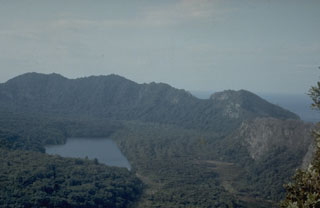 The caldera wall seen here is the N and E portion of the youngest Mayor Island caldera that formed about 6,300 years ago. The 2.2 x 2.5 km caldera floor is covered by young lava flows, the latest of which may have been erupted only about 500-1,000 years ago.
The caldera wall seen here is the N and E portion of the youngest Mayor Island caldera that formed about 6,300 years ago. The 2.2 x 2.5 km caldera floor is covered by young lava flows, the latest of which may have been erupted only about 500-1,000 years ago.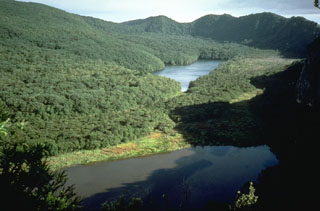 The caldera wall at the upper right was created during the youngest caldera-forming eruption of Mayor Island about 6,300 years ago. Major explosive eruptions at this time produced more than 1 km3 of tephra that deposited across the Bay of Plenty in the North Island. The 2.2 x 2.5 km wide caldera was subsequently partially filled by lava flows and domes, the latest of which may have been erupted as recently as 500-1,000 years ago.
The caldera wall at the upper right was created during the youngest caldera-forming eruption of Mayor Island about 6,300 years ago. Major explosive eruptions at this time produced more than 1 km3 of tephra that deposited across the Bay of Plenty in the North Island. The 2.2 x 2.5 km wide caldera was subsequently partially filled by lava flows and domes, the latest of which may have been erupted as recently as 500-1,000 years ago. Mayor Island in the Bay of Plenty is seen here from the W. The low, 4-km-wide island, also known as Tuhua, is the summit of the broad 15-km-wide volcano. A 3-km-wide caldera formed during two or three collapse events, the latest of which followed a major explosive eruption about 6,300 years ago. Mayor Island was recognized as an active volcano only within the past two decades. Its latest eruption may have occurred only 500-1,000 years ago.
Mayor Island in the Bay of Plenty is seen here from the W. The low, 4-km-wide island, also known as Tuhua, is the summit of the broad 15-km-wide volcano. A 3-km-wide caldera formed during two or three collapse events, the latest of which followed a major explosive eruption about 6,300 years ago. Mayor Island was recognized as an active volcano only within the past two decades. Its latest eruption may have occurred only 500-1,000 years ago.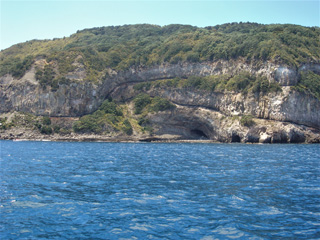 The eroded flank of Mayor Island (Tuhua) shows a sequence of overlapping columnar-jointed lava flows with black obsidian lavas between them.
The eroded flank of Mayor Island (Tuhua) shows a sequence of overlapping columnar-jointed lava flows with black obsidian lavas between them.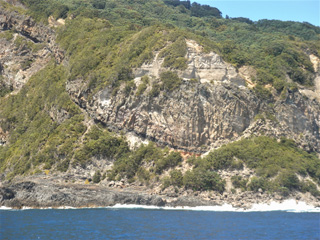 Mayor Island (Tuhua) is the top of a 700-m-high volcano with a 3-km-wide caldera forming much of the surface. Lava domes and flows have been emplaced across the island, with those seen here interbedded with obsidian layers.
Mayor Island (Tuhua) is the top of a 700-m-high volcano with a 3-km-wide caldera forming much of the surface. Lava domes and flows have been emplaced across the island, with those seen here interbedded with obsidian layers.The following 7 samples associated with this volcano can be found in the Smithsonian's NMNH Department of Mineral Sciences collections, and may be availble for research (contact the Rock and Ore Collections Manager). Catalog number links will open a window with more information.
| Catalog Number | Sample Description | Lava Source | Collection Date |
|---|---|---|---|
| NMNH 116210-1 | Obsidian | -- | -- |
| NMNH 116210-2 | Obsidian | -- | -- |
| NMNH 116210-3 | Obsidian | -- | -- |
| NMNH 116418-5 | Welded Tuff | -- | -- |
| NMNH 116418-6 | Welded Tuff | -- | -- |
| NMNH 116418-7 | Welded Tuff | -- | -- |
| NMNH 116418-8 | Welded Tuff | -- | -- |
| Copernicus Browser | The Copernicus Browser replaced the Sentinel Hub Playground browser in 2023, to provide access to Earth observation archives from the Copernicus Data Space Ecosystem, the main distribution platform for data from the EU Copernicus missions. |
| MIROVA | Middle InfraRed Observation of Volcanic Activity (MIROVA) is a near real time volcanic hot-spot detection system based on the analysis of MODIS (Moderate Resolution Imaging Spectroradiometer) data. In particular, MIROVA uses the Middle InfraRed Radiation (MIR), measured over target volcanoes, in order to detect, locate and measure the heat radiation sourced from volcanic activity. |
| MODVOLC Thermal Alerts | Using infrared satellite Moderate Resolution Imaging Spectroradiometer (MODIS) data, scientists at the Hawai'i Institute of Geophysics and Planetology, University of Hawai'i, developed an automated system called MODVOLC to map thermal hot-spots in near real time. For each MODIS image, the algorithm automatically scans each 1 km pixel within it to check for high-temperature hot-spots. When one is found the date, time, location, and intensity are recorded. MODIS looks at every square km of the Earth every 48 hours, once during the day and once during the night, and the presence of two MODIS sensors in space allows at least four hot-spot observations every two days. Each day updated global maps are compiled to display the locations of all hot spots detected in the previous 24 hours. There is a drop-down list with volcano names which allow users to 'zoom-in' and examine the distribution of hot-spots at a variety of spatial scales. |
|
WOVOdat
Single Volcano View Temporal Evolution of Unrest Side by Side Volcanoes |
WOVOdat is a database of volcanic unrest; instrumentally and visually recorded changes in seismicity, ground deformation, gas emission, and other parameters from their normal baselines. It is sponsored by the World Organization of Volcano Observatories (WOVO) and presently hosted at the Earth Observatory of Singapore.
GVMID Data on Volcano Monitoring Infrastructure The Global Volcano Monitoring Infrastructure Database GVMID, is aimed at documenting and improving capabilities of volcano monitoring from the ground and space. GVMID should provide a snapshot and baseline view of the techniques and instrumentation that are in place at various volcanoes, which can be use by volcano observatories as reference to setup new monitoring system or improving networks at a specific volcano. These data will allow identification of what monitoring gaps exist, which can be then targeted by remote sensing infrastructure and future instrument deployments. |
| Volcanic Hazard Maps | The IAVCEI Commission on Volcanic Hazards and Risk has a Volcanic Hazard Maps database designed to serve as a resource for hazard mappers (or other interested parties) to explore how common issues in hazard map development have been addressed at different volcanoes, in different countries, for different hazards, and for different intended audiences. In addition to the comprehensive, searchable Volcanic Hazard Maps Database, this website contains information about diversity of volcanic hazard maps, illustrated using examples from the database. This site is for educational purposes related to volcanic hazard maps. Hazard maps found on this website should not be used for emergency purposes. For the most recent, official hazard map for a particular volcano, please seek out the proper institutional authorities on the matter. |
| IRIS seismic stations/networks | Incorporated Research Institutions for Seismology (IRIS) Data Services map showing the location of seismic stations from all available networks (permanent or temporary) within a radius of 0.18° (about 20 km at mid-latitudes) from the given location of Tuhua/Mayor Island. Users can customize a variety of filters and options in the left panel. Note that if there are no stations are known the map will default to show the entire world with a "No data matched request" error notice. |
| UNAVCO GPS/GNSS stations | Geodetic Data Services map from UNAVCO showing the location of GPS/GNSS stations from all available networks (permanent or temporary) within a radius of 20 km from the given location of Tuhua/Mayor Island. Users can customize the data search based on station or network names, location, and time window. Requires Adobe Flash Player. |
| DECADE Data | The DECADE portal, still in the developmental stage, serves as an example of the proposed interoperability between The Smithsonian Institution's Global Volcanism Program, the Mapping Gas Emissions (MaGa) Database, and the EarthChem Geochemical Portal. The Deep Earth Carbon Degassing (DECADE) initiative seeks to use new and established technologies to determine accurate global fluxes of volcanic CO2 to the atmosphere, but installing CO2 monitoring networks on 20 of the world's 150 most actively degassing volcanoes. The group uses related laboratory-based studies (direct gas sampling and analysis, melt inclusions) to provide new data for direct degassing of deep earth carbon to the atmosphere. |
| Large Eruptions of Tuhua/Mayor Island | Information about large Quaternary eruptions (VEI >= 4) is cataloged in the Large Magnitude Explosive Volcanic Eruptions (LaMEVE) database of the Volcano Global Risk Identification and Analysis Project (VOGRIPA). |
| EarthChem | EarthChem develops and maintains databases, software, and services that support the preservation, discovery, access and analysis of geochemical data, and facilitate their integration with the broad array of other available earth science parameters. EarthChem is operated by a joint team of disciplinary scientists, data scientists, data managers and information technology developers who are part of the NSF-funded data facility Integrated Earth Data Applications (IEDA). IEDA is a collaborative effort of EarthChem and the Marine Geoscience Data System (MGDS). |